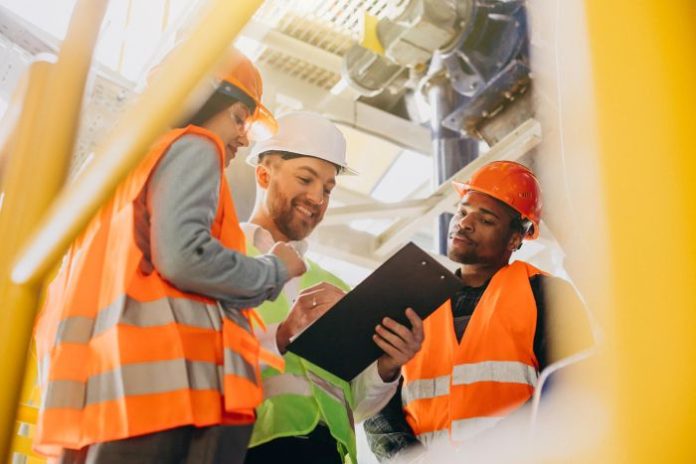Keeping worksites compliant no longer depends on endless forms or clipboards. Technology now gives safety leaders faster insight, sharper oversight, and stronger protection for every crew member—while making OSHA compliance easier to maintain than ever before.
From AI cameras to connected wearables, new tools are changing how compliance fits into daily operations. What once required hours of tracking and reporting now happens in real time.
Here’s a closer look at the tech reshaping OSHA compliance, helping teams stay safe, efficient, and ready for whatever the job brings.
Key Takeaways
- Technology transforms safety compliance by providing real-time insights and reducing paperwork.
- AI video analytics and connected wearables proactively monitor and alert for safety hazards.
- Mobile microlearning and VR simulations enhance continuous training for better hazard awareness.
- Predictive maintenance and smart sensors prevent equipment failures and monitor environmental conditions actively.
- Digital platforms streamline permit processes and OSHA log management for effective compliance and transparency.
Table of contents
- AI Video Analytics for Real-Time Safety Monitoring
- Connected Wearables for Proactive Safety Alerts
- Mobile Microlearning Platforms for Continuous Training
- Drone Inspections for Faster, Safer Site Reviews
- Analytics for Smarter OSHA Log Management
- Predictive Maintenance Software for Equipment Safety
- Digital Permit-to-Work Systems for Controlled Access
- Virtual Reality Simulations for Hazard Training
- Smart Environmental Sensors for the Final Layer of Safety
- Wrapping Up
AI Video Analytics for Real-Time Safety Monitoring
Modern worksites rely on AI video analytics to spot hazards before they turn into incidents. Cameras link to software that flags unsafe behavior like missing PPE or blocked exits. The system sends alerts straight to supervisors, saving response time and reducing paperwork.
Companies choose platforms that integrate with existing security feeds and deliver clear compliance reports. When evaluating ROI, they look for reduced injury rates, faster corrective actions, and fewer violations logged during OSHA inspections.
Connected Wearables for Proactive Safety Alerts
In the same way AI video tools improve oversight, connected wearables strengthen on-site awareness. These devices track movement, proximity, and even body temperature to detect early signs of risk.
Smart helmets and wrist sensors send instant alerts if a worker nears unsafe zones or shows signs of fatigue. The collected data syncs with compliance dashboards, helping safety managers spot patterns, verify training completion, and act on issues before they become reportable incidents.

Mobile Microlearning Platforms for Continuous Training
Training remains the backbone of safety, and mobile microlearning platforms make it easier to deliver. Workers can complete short safety modules directly on their phones during breaks or between tasks, keeping lessons practical and fresh.
Supervisors monitor completion rates, assign refresher topics, and track team performance through simple dashboards. These platforms also connect employees to official OSHA Outreach courses such as OSHA 10 and OSHA 30, supporting OSHA certification while cutting downtime and improving long-term compliance readiness.
Drone Inspections for Faster, Safer Site Reviews
Drone technology has changed how safety teams inspect job sites. High-resolution cameras capture detailed images of structures and hard-to-reach areas, eliminating the need for scaffolding or confined-space entry.
Supervisors receive live footage and auto-generated reports that align with OSHA safety checklists. This streamlines documentation, reduces inspection time, and minimizes missed hazards. Teams benefit from stronger audit readiness, fewer risks, and clear visual records that support compliance across every project phase.
Analytics for Smarter OSHA Log Management
Data analytics tools now simplify how companies manage OSHA logs and incident reports. Instead of manual entry, these systems collect data from wearables, sensors, and mobile apps, then organize it into real-time dashboards.
Safety leaders identify trends, track corrective actions, and compare performance across sites with clear visuals. Automated alerts flag missing entries or repeated violations before audits occur. The outcome is fewer reporting errors, faster documentation, and stronger proof of compliance during both internal and regulatory reviews.
Predictive Maintenance Software for Equipment Safety
Equipment failure often leads to safety incidents, and predictive maintenance software helps stop those risks early. Sensors track vibration, temperature, and run time, then analyze data to forecast when machinery needs attention.
Maintenance teams receive alerts before breakdowns happen, keeping tools safe and compliant with OSHA standards. The software also stores inspection logs automatically, giving auditors clear records without manual tracking. Companies using predictive systems report fewer equipment-related injuries and longer asset life, creating safer and more efficient job sites.
Digital Permit-to-Work Systems for Controlled Access
Many worksites now rely on digital permit-to-work systems to manage who can perform high-risk tasks. These platforms replace paper permits with secure, cloud-based workflows that track authorization, PPE requirements, and task-specific hazards.
Supervisors approve or revoke access instantly, keeping records transparent and traceable. The system integrates with training databases to verify worker eligibility before issuing a permit. This reduces human error, speeds up approval times, and maintains full compliance documentation for OSHA audits and internal safety reviews.
Virtual Reality Simulations for Hazard Training
Virtual reality has moved beyond gaming into practical safety training. Workers use VR headsets to experience real-world job hazards in a controlled digital space, learning how to react before facing actual risks.
These simulations cover everything from confined-space entry to fall protection, giving employees hands-on practice without danger. Trainers track performance metrics, identify weak areas, and adjust lessons to meet OSHA standards. The result is higher retention, better hazard awareness, and stronger compliance across all experience levels.
Smart Environmental Sensors for the Final Layer of Safety
As the last tool on this list, smart environmental sensors complete the modern compliance toolkit. These compact devices monitor air quality, noise, temperature, and chemical exposure in real time.
When readings exceed safe limits, automatic alerts reach supervisors and safety staff instantly. Data feeds directly into compliance dashboards, creating continuous environmental tracking without manual testing. The insight helps prevent violations, supports transparent OSHA reporting, and protects worker health through early detection of changing site conditions.
Wrapping Up
Modern safety isn’t about more paperwork; it’s about smarter visibility. Each tech tool turns compliance into an active, measurable process instead of a reactive one.
When leaders invest in digital oversight for OSHA compliance, they create safer environments and more confident teams. The right mix of technology keeps worksites running smoothly, protects people, and builds a culture where safety evolves alongside innovation.











